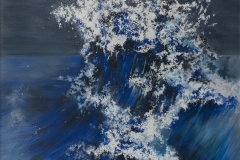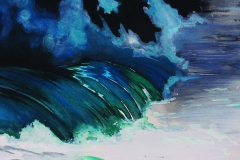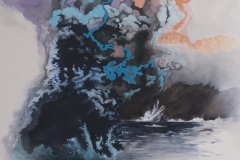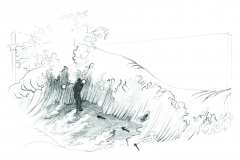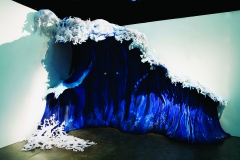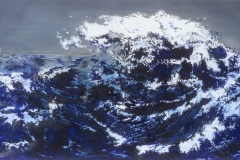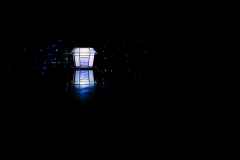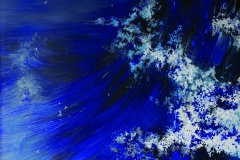Sobre la obra Tsunami en zona franca presentada en el Premio Petrobras Arte Ba y en Balnearios, La Munich Contemporánea, 2008, por Paula Senderowicz.
Un fragmento de una gran ola, con pequeñas mirillas en la superficie que permiten ver otro escenario en su interior, el de una casilla flotante en la oscura inmensidad.
En el paisaje exterior, el volumen de la ola parece atravesar la pared límite de la sala. Prima el color azul, brillante, que resplandece según las variaciones de luz. La pieza invita a penetrar en sus formas y a contemplar el paisaje interno, que se compone en otra escala.
La palabra tsunami, que viene del japonés (TSU: puerto o bahía, NAMI: ola), ingresó a nuestro vocabulario con una catástrofe; con la infinita cantidad de información sobre la tragedia, resurge un icono gráfico, la famosa ola de Katsushika Hokusai (Japón,1830-1832). La imagen congela la belleza que encierra peligro; iinvestiga los vericuetos de una tradición fundacional: el momento en que el hombre inventó la naturaleza. La pregunta sobre la naturaleza, quien continúa presentándose como indomable y nos sigue despertando pensamientos de lo sublime cuando nos reconocemos impotentes y fugaces.
A través de perforaciones en la superficie del paisaje, la mirada espía, explora el detalle; de lo inmenso a lo pequeño, de lo denso a lo acuoso, de la velocidad al detenimiento. La maqueta interna reproduce un refugio con estructura de madera, traslúcido, que flota y se refleja sobre la superficie del agua en una especie de zona franca.
Las zonas francas, son espacios transitorios donde las mercaderías no están sometidas a control ni gravadas por el pago de tributos. No está permitido habitar, tampoco hay límites geográficos ni controles culturales, sí libertad de criterios. En el corazón de esta ola, hay un pequeño espacio para la inmensidad íntima. Arriba el viento, abajo el agua, las vibraciones del agua dominan el vacío.
About Tsunami in the free zone , installation, 2008, by Paula Senderowicz
A piece of a huge wave with small peepholes in the surface that allow one to view another scene inside, that of a floating cabin amidst immense darkness.
In the external landscape the wave’s volume seems to go through the wall that surrounds the room. The shiny blue colour dominates and glitters in accordance with the changes in light. The piece invites one to penetrate its form and to contemplate the interior landscape, composed on another scale.
The word tsunami, from the Japanese (TSU: port or bay, NAMI: wave), entered our vocabulary due to a catastrophe. Along with an infinite amount of information about the tragedy there is a resurgence of a graphic icon, the famous wave from Katsushika Hokusai (Japan, 1830-1832). The image freezes the beauty that holds the danger; it questions nature which continues to be presented as unconquerable & awakes in us feelings of the sublime as we find ourselves again fleeing & impotent.
Through perforations in the landscape’s surface the viewer can spy and explore the detail. From the huge to the small, from the dense to the watery, from the fast to the still. The interior model is a reproduction of a shelter with a wooden, translucent structure that floats and reflects its image on the water surface in a kind of free zone.
The free zones are transitory spaces where goods are not subject to control nor payment of duty. It is not permitted to live there and there are neither geographic boundaries nor cultural controls but there is freedom of criteria. There is a small space in the heart of this wave for an intimate immensity. Above, the wind; beneath, the water whose vibrations dominate the emptiness.
